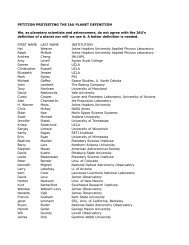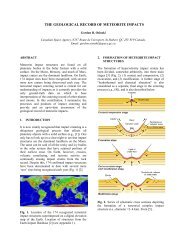Instrument calibration of the Hayabusa near-infrared spectrometer
Instrument calibration of the Hayabusa near-infrared spectrometer
Instrument calibration of the Hayabusa near-infrared spectrometer
Create successful ePaper yourself
Turn your PDF publications into a flip-book with our unique Google optimized e-Paper software.
element between light and dark frames. The NIRS frame length is 65.536 ms, whichcorresponds to half <strong>of</strong> <strong>the</strong> shutter driving cycle, and exposure time can be changed at256-stage from 0.256 ms to 57.344 ms. In addition, <strong>the</strong> number <strong>of</strong> stacked light-dark frameset can be also changed from 1 to 2 255 as n-th power <strong>of</strong> two. Most <strong>of</strong> NIRS data were taken inthis mode.The basic unit <strong>of</strong> spectral data for any given NIRS channel is digital number (DN)showing <strong>the</strong> integrated photon counts during a setting exposure-time interval. The raw dataare originally sampled with 14 bits per channel (0-16383 DNs). A DN has a value <strong>of</strong>approximately 0.565 mV output from <strong>the</strong> detector pre-amplifiers when at gain 1.08 ×. In <strong>the</strong>NORMAL mode, <strong>the</strong> data averaging <strong>of</strong> light frames subtracted dark spectrum are operatedwith onboard s<strong>of</strong>tware, and only <strong>the</strong> mean, deviation, maximum and minimum <strong>of</strong> <strong>the</strong> DNs atindividual channels were downloaded in instrument telemetry. The RAW mode prohibits <strong>the</strong>data averaging on board <strong>the</strong> spacecraft. The HIST mode provides a sequential output <strong>of</strong> <strong>the</strong>housekeeping (HK) data for NIRS. However, <strong>the</strong> RAW and HIST modes have not been usedin reality until <strong>the</strong> completion <strong>of</strong> <strong>the</strong> asteroid observation.The LIDAR and FLASH modes were supposed to be used in <strong>the</strong> descent andtouchdown phase during <strong>the</strong> <strong>Hayabusa</strong> rendezvous with Itokawa. In <strong>the</strong> LIDAR mode, NIRScarries out <strong>the</strong> frame difference readout in sync with <strong>the</strong> periodic laser pulse <strong>of</strong> LIDAR (alaser ranging instrument on <strong>the</strong> <strong>Hayabusa</strong>) so as to observe <strong>the</strong> reflected laser light <strong>of</strong> <strong>the</strong>LIDAR from <strong>the</strong> asteroid surface. The shutter stays open during this observation mode. On<strong>the</strong> o<strong>the</strong>r hand, <strong>the</strong> FLASH mode was designed to remove <strong>the</strong> frame contaminated byflashlights to irradiate target markers for autonomous navigation <strong>of</strong> sampling. This mode isidentical to <strong>the</strong> NORMAL mode, excluding <strong>the</strong> removal <strong>of</strong> <strong>the</strong> synchronized frame withflashlights.4. Pre-launch Calibration and CharacterizationThe NIRS instrument was tested and calibrated extensively at <strong>the</strong> piece-part andinstrument levels to verify its performance and to define its operational characteristics tolevels required to meet <strong>the</strong> science objectives. The tests and <strong>calibration</strong>s were carried out atambient and vacuum chamber conditions. Also <strong>the</strong> instrument underwent extensivevibrational and <strong>the</strong>rmal vacuum testing.The ground testing and <strong>calibration</strong>s <strong>of</strong> NIRS were conducted primarily at <strong>the</strong> Institute <strong>of</strong>Space and Astronautical Science (ISAS), Japan. The tests at <strong>the</strong> piece-part level includedmeasurements <strong>of</strong> detector li<strong>near</strong>ity, responsivity as functions <strong>of</strong> wavelength and temperature6


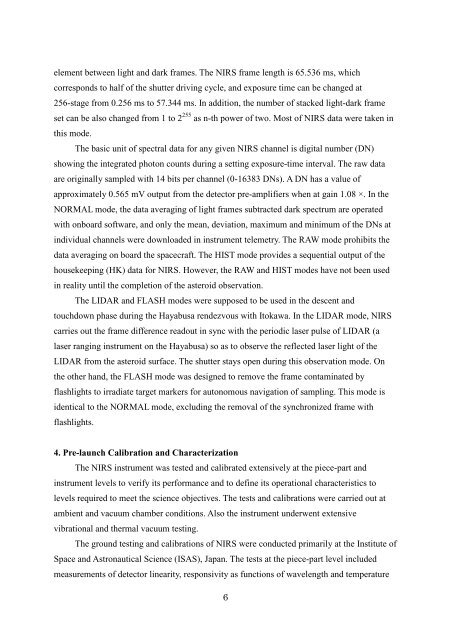
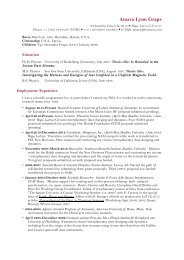
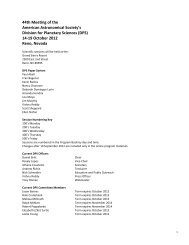
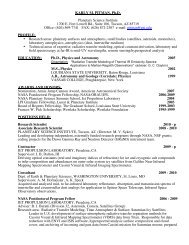
![Large-Aperture [OI] 6300 Ã
Photometry of Comet Hale-Bopp ...](https://img.yumpu.com/37144207/1/190x245/large-aperture-oi-6300-a-photometry-of-comet-hale-bopp-.jpg?quality=85)
